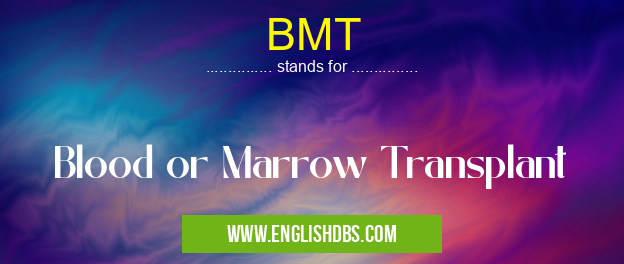What does BMT mean in TRANSPLANTATION
BMT stands for Blood or Marrow Transplant. It is a medical procedure that involves replacing damaged or diseased blood-forming cells with healthy ones. This procedure is typically used to treat blood cancers, such as leukemia, lymphoma, and myeloma, as well as other blood disorders and genetic diseases.

BMT meaning in Transplantation in Medical
BMT mostly used in an acronym Transplantation in Category Medical that means Blood or Marrow Transplant
Shorthand: BMT,
Full Form: Blood or Marrow Transplant
For more information of "Blood or Marrow Transplant", see the section below.
What is BMT?
BMT is a complex procedure that involves several steps:
- Harvesting: Healthy blood-forming cells are collected from a donor, either through apheresis (a process that separates blood cells) or bone marrow aspiration (a procedure that removes marrow from the hip bone).
- Conditioning: The patient receives chemotherapy and/or radiation therapy to destroy the damaged or diseased cells in their bone marrow.
- Transplant: The harvested healthy cells are infused into the patient's bloodstream, where they travel to the bone marrow and begin to produce new blood cells.
Types of BMT
There are two main types of BMT:
- Autologous BMT: The patient receives their own healthy cells, which were harvested before the conditioning treatment.
- Allogeneic BMT: The patient receives healthy cells from a compatible donor, who is typically a family member or unrelated individual.
Post-Transplant Care
After BMT, the patient's immune system is weakened, making them vulnerable to infections. They will require close monitoring and supportive care, including:
- Anti-infective medications
- Blood transfusions
- Platelet transfusions
- Nutrition support
Essential Questions and Answers on Blood or Marrow Transplant in "MEDICAL»TRANSPLANTATION"
What is a BMT (Blood or Marrow Transplant)?
BMT is a medical procedure that involves replacing damaged or diseased bone marrow with healthy bone marrow from a donor. It is used to treat a variety of conditions, including leukemia, lymphoma, sickle cell anemia, and aplastic anemia.
What is the difference between an autologous and allogeneic BMT?
In an autologous BMT, the patient's own bone marrow is harvested and stored before receiving a high dose of chemotherapy or radiation to kill the diseased cells. The stored bone marrow is then re-infused into the patient to restore healthy blood cell production. In an allogeneic BMT, bone marrow is taken from a donor, typically a family member or unrelated volunteer, and transplanted into the patient.
Who is eligible for a BMT?
Eligibility for a BMT depends on factors such as the type of underlying condition, the patient's age and overall health, and the availability of a suitable donor.
What are the risks associated with a BMT?
As with any major medical procedure, BMT carries certain risks, including infection, bleeding, graft-versus-host disease (GVHD), and relapse of the underlying condition.
What is the process of a BMT?
The BMT process involves several stages:
- Conditioning: Chemotherapy or radiation is used to destroy the diseased bone marrow and prepare the patient for the transplant.
- Harvesting: The donor's bone marrow is collected through a procedure called apheresis.
- Transplantation: The donor's bone marrow is infused into the patient's bloodstream.
- Recovery: The patient's immune system and blood counts gradually recover after the transplant.
What is the prognosis after a BMT?
The prognosis after a BMT depends on several factors, including the underlying condition, the type of BMT performed, and the patient's overall health.
Final Words: BMT is a complex but potentially life-saving procedure for patients with blood cancers and other blood disorders. The success of the transplant depends on various factors, including the patient's overall health, the type of disease being treated, the compatibility of the donor cells, and the experience of the transplant team.
BMT also stands for: |
|
| All stands for BMT |
